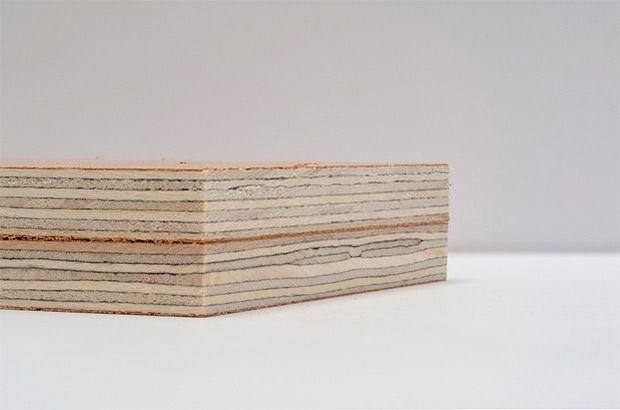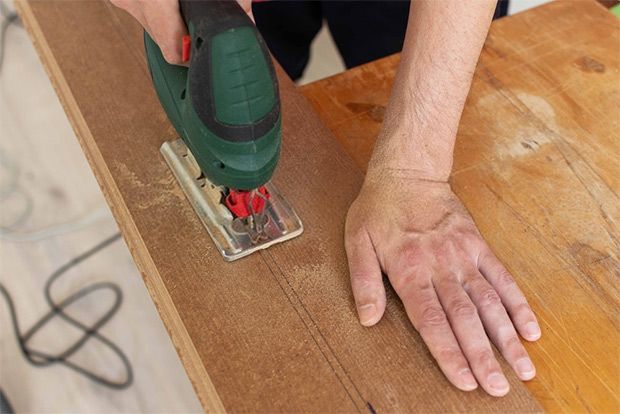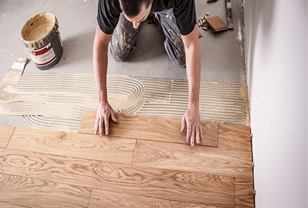How To Cut Laminate With Simple Methods
However, the brittle nature of laminate requires some extra attention when cutting. This guide will show you how to cut laminate and have the best finish with different tools.
Preparations
Measure And Buy The Amount Of Laminate Needed
Measure the area you want to install laminate (flooring or countertops) with measuring tapes.
Do it carefully and add one or two inches to every side. This makes sure you won't' run short of laminate when splitting or chipping happens when cutting. Then buy some more laminate (5-10%) than the dimensions above to account for mistakes and waste.

Measure and buy your laminate sheets
Allow The Laminate Sheets To Acclimate
Laminate is a special material that can't be used immediately. Humidity exposure can contract and expand it to a significant extent.
After getting laminate sheets on your hands, open the boxes and let them sit in your home for about three days before carrying out the job. This acclimatization allows the laminate sheets to get used to the humidity level of your room and stretch to its true size.
If you ignore this step, there is a risk the laminate will buckle or pull apart after the installation.
➜ RELATED: How To Shine Laminate Floors: The Best Practical Way
Choose Your Cutting Tool
There are many tools you can utilize to cut laminate, from a pair of high-pressure cutting shears to a table saw.
Regardless of the tool you pick, its blades should be extremely thin and sharp. A thinner blade creates fewer chips and splits when you cut laminate.
Types Of Cutting Tool
Common options are hand saws, miter saws, jigsaws, circular saws, and table saws.
If you plan to deal with a lot of laminate, renting or even purchasing a laminate floor cutter can be a good idea too. They are efficient in cutting laminate, easy to use, and produce no toxic dust.
Table Saws
With the right setup and technique, table saws can make very accurate cuts. They are also a great choice for rip cuts.
The biggest downside of these powerful saws is that they are not portable tools. You may have to bring the laminate sheets to your workshop instead of doing your work on site.
Jigsaws
These power saws use a vertical blade to get the job done. They work best with rounded shapes and curves.
However, jigsaws work like circular models when you make straight cuts free one-handedly with them.
Miter Saws
These saws are stationary tools, meaning you can have an easier time making angled or straight cuts with great precision.
Circular Saws
Like miter saws, circular saws feature a round cutting disc. They are more portable, and you can carry them to the site when you want to install laminate.
Keep in mind that without a saw track or guide, it is difficult to produce high-precision cuts when cutting laminate sheets.

Circular saws are a popular tool for cutting laminate
Rotary tools
These versatile tools can work with laminate as well. They are a great additional tool and can come in handy when you make small accurate cuts. But rotary tools don't have the muscle to deal with a whole project, especially with flooring.
Choose The Right Saw Blade
The saw blade can make or break your cutting. A proper one produces clean cuts and doesn't lead to chipping, for example.
As we have mentioned above, many saw designs can be employed for cutting laminate. Each of them comes with a unique blade. The exceptions are circular and miter saws, which use round cutting discs.
Table Saws
Buy carbide-tipped blades with fine teeth (around 60 teeth per inch).
Jigsaws
When using them for laminate, it is recommended to invest in carbide-tipped blades to reduce wear and tear on the blade.
Miter Saws And Circular Saws
Use blades whose number of teeth ranges from 80 to 100. These blades can create finer and smoother cuts on laminate.
Saw Compatibility
It is crucial to ensure the blade is compatible with the saw when dealing with laminate.
For example, a set of blades that works great for other jigsaws won't help you at all if it features a larger or smaller arbor hole on the saw you currently have.
Sometimes it is possible to interchange the blades of circular and miter saws. But this is not always guaranteed.
Make sure the blade you intend to use on another saw is designed for it too. Check the size, whether it fits securely, and if everything is safe to operate. Otherwise, it won't fit or even break in use, sending dangerous pieces of sharp metals all over your workplace.
➜ RELATED: The Best Way To Clean Laminate Floors To Protect Its Shiny Finish
Blade Diameter
This aspect is a concern only with circular and miter saws, where you have to use round discs to cut laminate. The disc has to be in the right size to fit the saw.
Most miter saws use 10 or 12-inches blades, while this range for circular models is from 6.5 to 12 inches. Some models can accommodate smaller or bigger blades to make more accurate or longer cuts.
The kerf is another important consideration of a saw blade. Use only think kerfs when your work involves laminates. This way, you can have accurate and clean cuts with less effort.
Wider kerfs may pull at the laminate's sides when cutting and create large chips.
Number Of Teeth
Some diamond-tipped blades are designed with fiber cement and laminate in mind. They typically have a lower number of teeth.
This design reduces the amount of dust created during the cutting. It doesn't sacrifice much power either, making it a great choice for things like ripping laminate flooring.
On the other hand, miter and circular saw blades used for laminate often have from 80 to 100 teeth. The goal is a higher degree of cutting precision.
Remember that while a high number of teeth makes it easier to make clean cuts, the motor of your saw will be put under greater strain. The more teeth the blade has, the more friction it produces while rotating.
Arbor Size
Miter and circular saws support their blades with an assembly called the arbor. It features a spindle or shaft that protrudes through the center of the blade. And thus, that hold is also known as the arbor hole.
The hole of a blade must fit the size of a saw's arbor unless you want to operate an unsafe tool. This size typically depends on the diameter of the blade.
For instance, 3-inch blades often have an arbor size of 0.25 inches, while 12-inch blades used for laminate usually have a 1-inch hole.
Bring Together Other Tools
In addition to the cutting tools, gather other equipment like non-permanent markers, gloves, safety goggles, and dust masks.
Don't forget to put on your protective gear, as the dust produced while cutting laminate can lead to serious health issues when it gets into your eyes or lungs.

Wear your protective equipment
A forge profile gauge should help you make curved or irregular shapes. It makes marking curved lines a breeze.
How To Cut Laminate
Cut Laminate To Length
Spread Your Laminate Sheets Out
Make sure that the sheets are laid out on the work surface so you can measure and mark them correctly.
Let them face up as you will cut them with the finished surface face up too.
Measure And Mark The Cut Lines
Use a measuring tape to determine where you need to cut. Mark the cut lines with non-permanent ink on the finished side.
Avoid using wax pencils for this job, as the lines they create can be difficult. Lines of non-permanent ink on laminate are highly visible, don't get dull easily, and can be cleaned with a damp cloth if you need to notice you have made a mistake.
Cut The Laminate
Use a handsaw or circular saw for this job. Put on your safety equipment.
Use the dust collection system of your saw if it has one. Attach the dust bag. If you anticipate a lot of dust, hook it up to a vacuum hose.
If your cutting tool has no built-in way to capture sawdust, put a bucket under your working table so the dust can fall into it.
Keep the finished side up and carefully move the saw along each line you have marked. Place painter's tape along these lines if you want to avoid chips.
When you're done with each cut, use a cloth to erase the remaining ink on the surface.
The edges of the newly cut laminate can be very sharp. Use protective gloves and be careful when handling them.
Cut Laminate To Width
Make A Template
To make accurate curves with little waste, make a template from a piece of paper to guide your cuts.
Hold it against the obstacle and trace around it. Cut along the marked line to create a copied shape of the obstacle.
After creating the paper template, put it back down to verify its shape. An accurate template can demand several attempts from you, so be patient.
If your project calls for a lot of curved cuts, you can use a contour gauge. Push it against the obstacle, lock it in place, and move the gauge back to your laminate to mark the cuts.
Cut The Laminate

Use a jigsaw to make curves
A jigsaw is a common tool for this kind of cutting. Mark the cutting lines with your marker and the paper template or profile gauge.
Carefully move the saw along the marked lines to make the cuts. When you're done, hold the cut laminate against the obstacle to confirm the shape. Make sure that it fits exactly right.
Wipe away the remaining ink from the laminate's surface with a damp cloth.
Safety Guide
Keep your protective gear on all the time. Cutting laminate can be dangerous for your eyes because of not only sawdust but also the kickback potential.
When the blade is pinched into the laminate, it can pop out and fly toward you. Make sure the blade is sharp and clean before cutting to minimize this risk.
Conclusion
Laminate can create rugged and long-lasting surfaces in floors, cabinet panels, and countertops. But you can only achieve the best result if you know how to cut laminate properly. Make sure that you measure, mark, and cut it carefully to prevent cracks and chipping.
FREQUENTLY ASKED QUESTIONS
- 01. How To Cut Laminate Without Chipping?
-
The plastic coating of laminate is the main reason behind the chipping. It tends to come off in pieces easily when cut to size. These chipped edges can lead to staining or even break down your flooring.
To increase the longevity of your laminate flooring, employ some methods to avoid chipping.
Use some low-tack masking tape to cover the finished surface of your laminate. Avoid standing masking tape as it can leave adhesive on your flooring and ruin its finish.
After cutting, sand the newly cut edges with some fine-finish sandpaper. Pull the tape off the surface of the laminate.
You can minimize the chipping further with a plywood-cutting blade. It should have a large number of teeth.
- 02. Can I Cut Laminate With A Utility Knife?
-
Totally, if you plan to cut flexible laminate strips. Remember that cutting laminate with utility knife requires changing the blades frequently.
- 03. What Do You Use To Cut Laminate Sheets?
-
A lot of tools can be used to cut laminate sheets, including handheld power saws, table saws, miter saws, circular saws, and jigsaws.
- 04. Can You Cut Laminate Sheets With Scissors?
-
A pair of sharp, heavy-duty scissors can cut through thin laminate sheets with ease. Many specialized shears for cutting laminate are also available.
However, they are not the best way to cut laminate if you want straight cuts.
- 05. What Saw To Cut Laminate Countertop?
-
In most cases, you can use any saw that can cut laminate sheets. A hand saw can do the trick. But power saws like a circular saw are the best way to cut laminate countertop sheets as they can get it done much quicker.
- 06. How To Shine Laminate Floors?
-
Use the best mop for laminate floors to clean and wipe away all the dust and debris on your flooring.
Microfiber is a popular choice as it can pick up dirt and spills quickly. The best mop for vinyl floors is also a great alternative as it usually has the same properties.
- 07. How To Cut Formica Sheets?
-
Formica is just a brand of laminate sheets. Learn how to cut laminate sheets and you can deal with Formica just fine.












